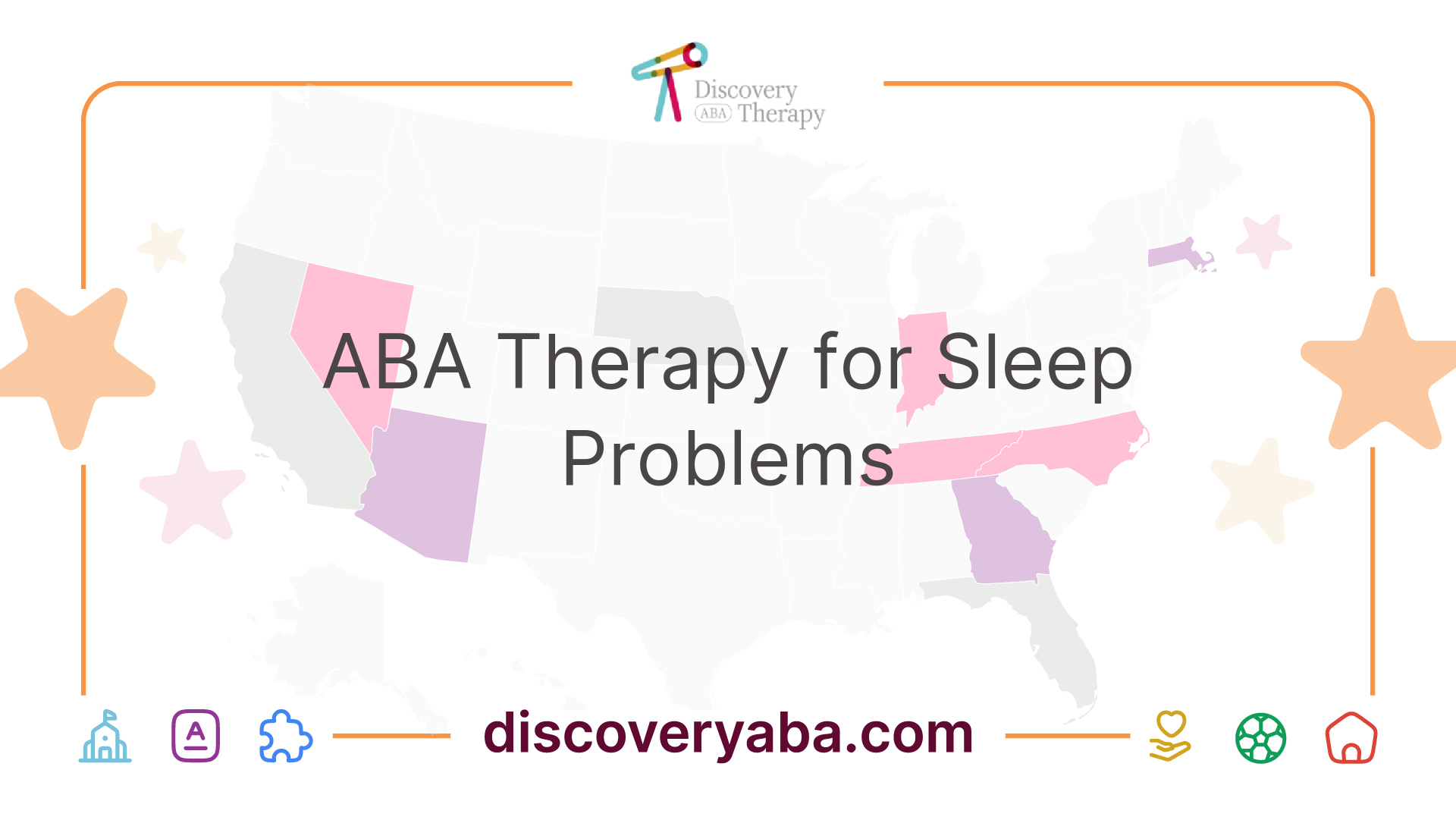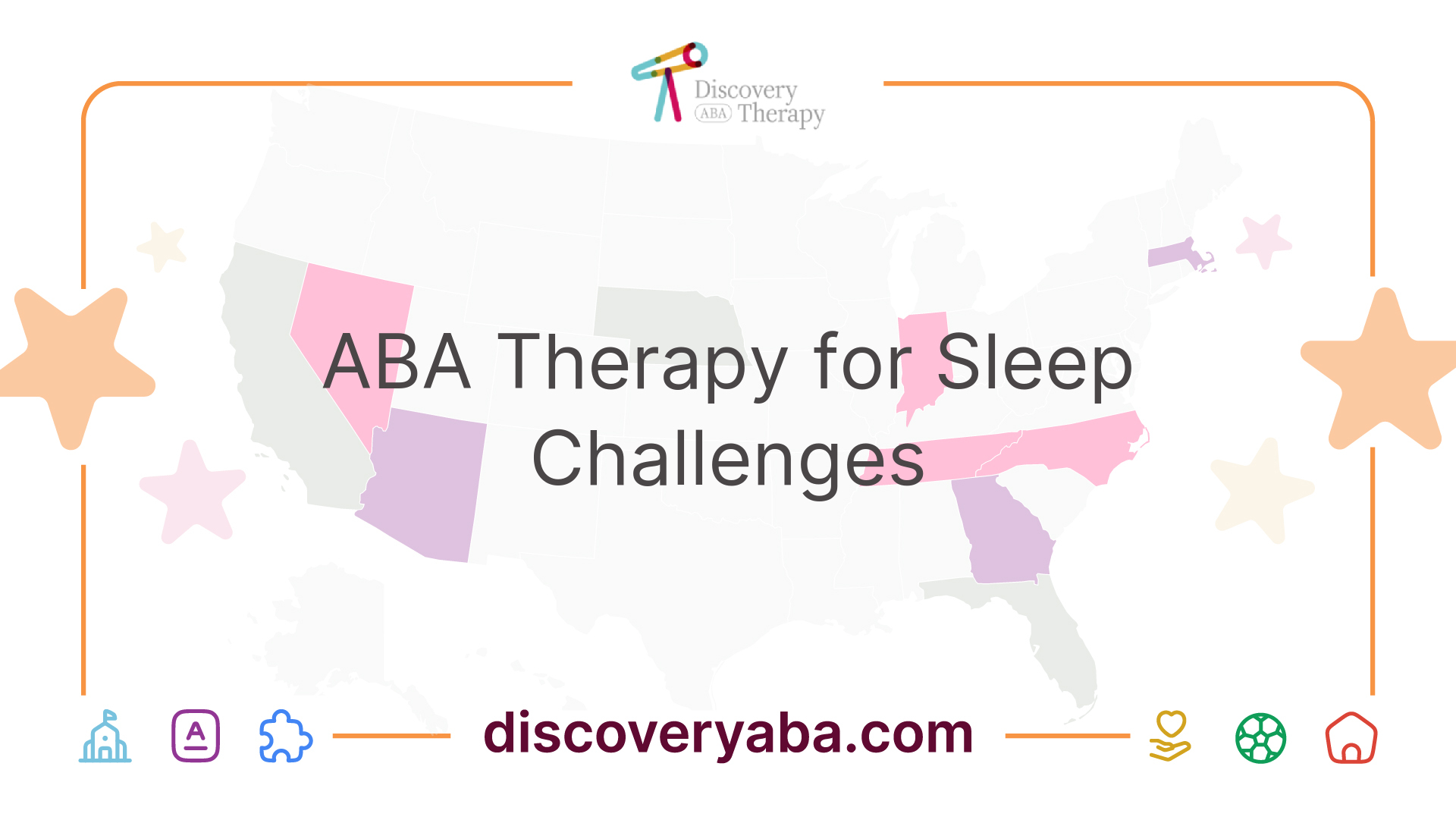ABA Therapy for Sleep Problems
Explore ABA therapy for sleep problems to improve your child's sleep quality and overall well-being.



Understanding Sleep Issues in Autism
Prevalence of Sleep Problems
Sleep problems are notably common among children with Autism Spectrum Disorder (ASD). Research indicates that approximately 53% of children aged 2 to 5 years with ASD report struggling with sleep issues. Alarmingly, 86% of these children experience sleep disturbances on a daily basis, highlighting a critical area of concern for parents and caregivers. The impact of these sleep problems can vary, but they often interfere with daily functioning and overall quality of life.
Age GroupPercentage with Sleep ProblemsDaily Sleep Issues (%)2-5 years53%86%
Impact of Sleep Disturbances
The consequences of sleep disturbances can be profound. Poor sleep may lead to increased irritability, difficulty concentrating, and challenges in social interactions. Children with sleep problems are more susceptible to behavioral issues, making it essential for parents and caregivers to seek effective interventions.
Evidence-based clinical guidelines recommend behavioral interventions as a first-line treatment for managing sleep challenges in autism, emphasizing the significance of applying suitable strategies such as ABA therapy. By utilizing techniques like positive reinforcement systems and gradual extinction protocols, caregivers can work towards improving sleep quality for their loved ones.
Understanding the prevalence and impact of sleep challenges in children with ASD is crucial in helping families navigate the complexities of sleep disorders and explore appropriate treatments. For further assistance, caregivers may also consider strategies for managing social isolation with aba and self-regulation strategies in aba that align with the overall therapy goals.
ABA Therapy for Sleep Challenges

Effectiveness of ABA Techniques
ABA therapy has demonstrated its effectiveness in addressing sleep difficulties among children with Autism Spectrum Disorder (ASD). A study found that 53% of children aged 2 to 5 years with ASD reported sleep problems, with an alarming 86% experiencing these issues daily [1]. Techniques derived from ABA have been shown to reduce various sleep disturbances, such as prolonged sleep onset latency, frequent nighttime awakenings, short sleep durations, and early rising times.
Table 1 below summarizes the common sleep disturbances and the effectiveness of ABA strategies in mitigating these issues:
Sleep DisturbanceABA EffectivenessProlonged sleep onset latencyHighFrequent awakeningsHighShort sleep durationModerateEarly rising timesHigh
The use of structured interventions in ABA provides parents and caregivers with valuable strategies tailored to the unique sleep challenges faced by children with ASD. Behavioral interventions are often recommended as a first-line treatment for sleep problems, emphasizing the critical role of ABA techniques [2].
Positive Reinforcement Strategies
Positive reinforcement is a key component of ABA therapy that encourages desired behaviors, including improved sleep patterns. Implementing a system of rewards helps to motivate the child to engage in activities that promote better sleep. When the child follows bedtime routines or sleeps through the night, they may receive praise, small rewards, or privileges.
The effectiveness of positive reinforcement in sleep interventions can be seen in its ability to create a structured environment that fosters predictable and calming bedtime routines. It can reduce anxiety surrounding sleep and positively impact overall sleep quality.
For example, the following elements are typically included in a positive reinforcement strategy for sleep improvement:
StrategyDescriptionConsistent Bedtime RoutineEstablishing a regular schedule for going to bed and waking up.Rewards for ComplianceOffering incentives for following the bedtime routine.Gradual ProgressionGradually increasing expectations for sleep behavior.
Through these positive reinforcement strategies, caregivers can leverage ABA principles to significantly enhance the sleep experience for children with autism. For further insights on behavioral interventions, explore our articles on self-regulation strategies in ABA and reducing aggression with ABA therapy.
Behavioral Interventions in ABA

Applied Behavior Analysis (ABA) therapy employs various behavioral interventions to help children with Autism Spectrum Disorder effectively manage their sleep problems. Among these, positive reinforcement systems and gradual extinction protocols are two popular strategies.
Positive Reinforcement Systems
Positive reinforcement is an effective technique for promoting desired behaviors by providing rewards. In the context of sleep challenges, this approach establishes a reward system for children who successfully stay in bed and sleep through the night. By motivating children through rewards, they can develop better sleep habits over time [3].
Desired BehaviorRewardStaying in bed all nightExtra story time in the morningFalling asleep independentlyA star sticker on a chartNot waking parents upSpecial treat or privilege
Creating a structured reward system helps children understand the connection between their actions and the positive outcomes. Parents and caregivers can work with ABA therapists to design a customized plan that involves achievable goals and appropriate rewards. This approach not only fosters healthier sleep patterns but also enhances the overall quality of life for both the children and their families.
Gradual Extinction Protocols
Gradual extinction protocols focus on teaching children self-soothing techniques, allowing them to fall asleep independently. This method involves slowly reducing the amount of assistance provided during bedtime. By gradually decreasing parental involvement, children gain confidence in their ability to self-soothe and go to sleep without relying on external support [3].
In practice, parents may follow a set plan that emphasizes when to offer support and when to step back. Each night, they might incrementally reduce the time spent in the room or the nature of their interactions. This gradual process can significantly reduce anxiety around bedtime for children and ultimately enhance the quality of their sleep.
For more insights into behavior modifications that may benefit sleep patterns, explore our articles on self-regulation strategies in ABA and improving executive function with ABA. These methodologies form a foundation for establishing consistent and healthy routines, ensuring better sleep outcomes for children with autism.
Supporting Sleep with ABA
Melatonin Supplements
Melatonin supplements are frequently recommended to assist in promoting better sleep for children with Autism Spectrum Disorder (ASD). Research indicates that approximately 86% of children with sleep problems experience these issues on a daily basis [1]. These supplements can effectively reduce the time it takes for a child to fall asleep and enhance overall sleep duration.
Melatonin is a hormone that regulates the sleep-wake cycle, and when supplemented appropriately, it can benefit children struggling with sleep disturbances. It is widely regarded as a safe option for children with ASD. Here is a summary of melatonin's benefits:
Benefits of MelatoninDescriptionReduces Sleep Onset TimeHelps children fall asleep fasterImproves Sleep DurationIncreases the total duration of sleepSafe for ChildrenGenerally considered safe when used properly
For more detailed information about melatonin and its use, parents and caregivers can consult with healthcare professionals.
Environmental Adjustments
In addition to melatonin supplements, modifying the sleeping environment can significantly enhance sleep quality for children with autism. Creating a calming bedroom atmosphere is essential to promote relaxation and successful sleep. Here are some key environmental adjustments that can be beneficial:
Environmental AdjustmentDescriptionReduce Noise LevelsUse white noise machines or earplugs to minimize disturbancesDim LightingEnsure that the bedroom is darkened to promote melatonin productionComfortable BeddingSelect soft, breathable bedding materials to improve comfort
Implementing these adjustments in conjunction with aba therapy for sleep problems can result in more restful nights. Continuous assessment and modification of the sleeping environment will help provide a positive impact on sleep behavior over time. Combining behavioral interventions and environmental alterations can support families in managing sleep challenges more effectively.
Research on ABA Therapy
Research surrounding ABA therapy for sleep problems has shown promising results in addressing the sleep issues commonly experienced by individuals with autism. The findings indicate the effectiveness of specific ABA interventions in improving sleep quality while also shedding light on evidence-based recommendations.
Study Findings on ABA Interventions
Recent studies have highlighted the benefits of behavioral interventions for managing sleep disturbances in autistic children. One notable intervention, known as the Sleeping Sound program, demonstrated significant improvements in sleep issues compared to traditional treatment methods.
Time PointEffect SizeP-Value3 Months Post-RandomizationModerate-to-large<0.0016 Months Post-RandomizationSmall-to-moderate<0.00112 Months Follow-UpSignificant Reduction<0.001
Children participating in the Sleeping Sound intervention reported a greater reduction in sleep problems at the 12-month follow-up, with an effect size of -0.4 [2]. Additionally, the research indicates that children who took sleep medication or had parents without psychological distress experienced even greater long-term benefits from this intervention.
Recommendations from Evidence-Based Guidelines
According to clinical guidelines, behavioral interventions are recommended as a first-line treatment for sleep problems in children with autism [2]. This endorsement reflects the effectiveness and sustainability of ABA techniques in improving sleep outcomes.
It is essential for parents and caregivers to consider these research findings when exploring options for their child's sleep difficulties. Customized ABA programs that incorporate proven strategies could lead to significant improvements in their child's overall sleep quality and, by extension, general well-being. For additional insights into supportive strategies, one may explore resources on self-regulation strategies in ABA and addressing meltdowns with ABA as they relate to sleep management.
Enhancing Sleep Quality
Benefits of Improved Sleep
Achieving better sleep is crucial for everyone, but especially for individuals with autism spectrum disorder (ASD). Improved sleep can significantly enhance their academic achievements, social interactions, and overall behavior. Research shows that sleep problems affect a substantial portion of the autism population, with prevalence rates ranging from 50% to 80% in children and about 80% in adults. This lack of sleep can lead to increased stress levels for caregivers.
Implementing ABA therapy for sleep problems not only helps individuals experience more restful nights, but it can also create positive ripple effects throughout their daily lives. The table below summarizes some key benefits of improved sleep for individuals with autism and their families:
BenefitDescriptionEnhanced BehaviorBetter sleep can lead to improved mood and behavior, reducing irritability and aggression.Improved Social InteractionsWell-rested individuals are more likely to engage positively with peers and family members.Increased FocusA good night's sleep aids concentration and learning, enhancing academic performance.Reduced Stress for CaregiversAnimprovingsleep can lessen the stress and fatigue experienced by caregivers, promoting a healthier family dynamic.
Addressing sleep issues through ABA therapy can yield long-lasting improvements, not only for individuals with ASD but also for their caregivers and families [3].
Customized ABA Programs
Customized ABA programs tailored to individual needs can effectively address sleep challenges. These programs promote family involvement, allowing caregivers to reinforce positive sleep behaviors at home. Techniques such as consistent bedtime routines, reward systems, and relaxation strategies can significantly enhance sleep quality.
A study indicated that 53% of children aged 2 to 5 years with ASD reported sleep problems, including bedtime resistance, insomnia, and daytime sleepiness [4]. By engaging in personalized ABA interventions, families can tackle these specific challenges and work towards achieving a more restful night for their loved ones.
Incorporating behavioral techniques into daily routines helps create an environment conducive to sleep. This approach not only promotes better sleep hygiene but also fosters a sense of security and predictability, which is crucial for many individuals with autism. For more insights on various ABA techniques and strategies, consider exploring our resources on self-regulation strategies in ABA and reducing aggression with ABA therapy. By customizing ABA programs, parents and caregivers can enhance sleep quality and overall well-being for those with ASD.
References
[2]:
[3]:
[4]:
Find More Articles

How ABA Therapy Helps Reduce Repetitive and Rigid Behaviors

Energy-Efficient Autism Community Resources

How to Use ABA Therapy to Reduce Excessive Repetitive Behaviors

The Role of Play in ABA Therapy

The Benefits of Combining ABA Therapy with Other Support Services

How ABA Therapy Helps Develop Self-Confidence in Children with Autism

The Role of Play-Based ABA Therapy in Early Childhood Development

The Role of Goal-Oriented Sessions in ABA Therapy

How ABA Therapy Works: A Step-by-Step Guide

The Role of Self-Management Strategies in ABA Therapy

How ABA Therapy Supports Emotional Expression in Children

The Role of Parent Training in ABA Programs

How ABA Therapy Supports Positive Transitions Between Activities

How to Reinforce ABA Learning in Community Settings

The Role of Functional Behavior Assessments in Preventing Problem Behaviors

How School-Based ABA Therapy Supports Classroom Success

How to Choose Between At-Home and Center-Based ABA Therapy

How ABA Therapy Helps Develop Conflict Resolution Skills

How to Identify the Best ABA Provider for Your Child

How to Use Token Economies in ABA Therapy

The Role of Peer Modeling in ABA Therapy Success

The Benefits of Naturalistic Teaching Approaches in ABA Therapy

What Is the ABCs of Behavior in ABA Therapy?

The Benefits of Group ABA Therapy for Social Skill Development

How to Encourage Positive Social Interactions with ABA Strategies

How to Introduce New Skills in ABA Therapy Without Overwhelming Your Child

The Benefits of Combining ABA Therapy with Other Interventions

Solar Power for Autism Support Networks

How to Address Hyperactivity with ABA Therapy

Common Misconceptions About ABA Therapy

Understanding the Principles of Positive Reinforcement

Understanding the Principles of Positive Reinforcement

Understanding the Principles of Positive Reinforcement

How ABA Therapy Supports Transitions Between Activities

Understanding the Principles of Positive Reinforcement

How to Identify and Celebrate Small Successes in ABA Therapy Progress

Understanding the Principles of Positive Reinforcement

How to Introduce Visual Schedules for Better Behavior Management

How ABA Therapy Can Reduce Self-Injurious Behaviors

How ABA Therapy Supports Academic Success

The Importance of Early Signs Recognition and ABA Intervention

How ABA Therapy Helps Improve Comprehension and Listening Skills

How to Use Visual Schedules to Support Your Child’s ABA Goals

How ABA Therapy Supports Self-Help Skills Like Dressing and Eating

How ABA Therapy Supports Behavioral Success in Community Settings

How ABA Therapy Helps Build Independence in Daily Activities

Building Social Skills Through ABA Therapy Techniques

The Role of School-Based Behavior Intervention Plans (BIPs)

The Benefits of Scripting and Role-Playing in ABA Therapy

How to Help Your Child Develop Coping Strategies with ABA Therapy

How to Address Hyperactivity and Attention Challenges with ABA Therapy

How to Help Your Child Develop Coping Strategies with ABA Therapy

How ABA Therapy Addresses Challenging Behaviors

The Importance of Social Skill Groups in ABA Therapy

How ABA Therapy Addresses Challenging Behaviors

The Role of Task Analysis in ABA Therapy for Teaching New Skills

How ABA Therapy Helps Improve Focus and Attention in the Classroom
%2520(1).jpeg)
Assessment Tools For People With Autism

Autism And Chronic Pain

How to Use Social Stories to Enhance ABA Therapy Outcomes

How ABA Therapy Helps Prepare Children for School Success

How School-Based ABA Therapy Can Improve Academic Performance

How to Address Resistance to ABA Therapy and Build Engagement

How to Use ABA Therapy to Develop Self-Help Skills in Daily Routines

How to Use Role-Playing in ABA Therapy for Skill Development

How to Handle Regression in Skills During ABA Therapy

How ABA Therapy Supports Social Communication Development

How to Find the Best ABA Therapy Provider for Your Child

How to Create a Reward System That Motivates Your Child in ABA Therapy

The Role of ABA Therapy in Preparing Children for Independent Living

How ABA Therapy Teaches Communication and Social Skills

How School-Based ABA Services Help Students with Autism Thrive

How ABA Therapy Helps Develop Patience and Waiting Skills

How to Support Your Child’s Social Interactions Using ABA Techniques

How ABA Therapy Addresses Anxiety and Fear Responses in Children

The Role of Play-Based ABA Therapy in Skill Development

How ABA Therapy Helps Build Confidence in Children with Autism

The Benefits of Center-Based ABA Therapy for School Readiness

The Role of ABA Therapy in Building Emotional Intelligence

How to Use Differential Reinforcement in ABA Therapy

Exploring Different ABA Techniques and Strategies

How to Prepare for IEP Meetings When Seeking ABA Therapy Support

How to Use ABA Therapy to Develop Resilience and Coping Mechanisms

How to Work with ABA Therapists to Set Realistic and Achievable Goals

How to Recognize Burnout in ABA Providers and Address It

The Connection Between ABA Therapy and Improved Social Skills

How ABA Therapy Helps Address Aggressive Behaviors
.jpeg)
Does Processed Food Cause Autism?

The Benefits of ABA Therapy for Adolescents with Autism

How to Reinforce ABA Strategies at Home for Consistent Progress

How to Create a Positive Learning Environment at Home with ABA

Autism And Dementia: The Connection and Differences

How ABA Therapy Supports a Lifetime of Learning and Growth

The Role of Functional Behavior Assessments in ABA

How ABA Therapy Helps with Anger Management Skills

How to Address Food Selectivity Using ABA Techniques

How ABA Therapy Supports a Smooth Transition to Middle and High School

How to Address Perseveration in ABA Therapy
Contact us
North Carolina, Tennessee, Nevada, New Jersey, Utah, Virginia
New Hampshire, Maine
Massachusetts, Indiana, Arizona, Georgia
.avif)


